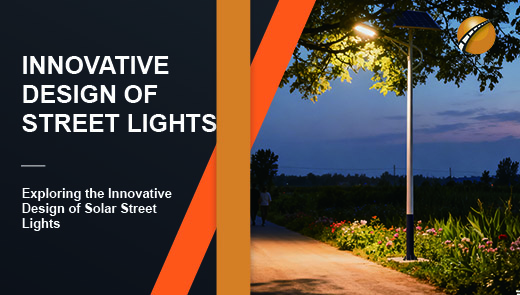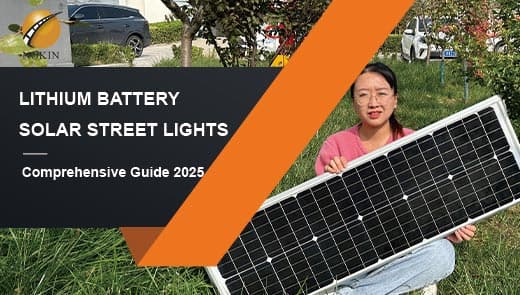The Ultimate Guide to Off-Grid Solar Street Lights
When it comes to off-grid solar street light, will you feel unfamiliar with it? In fact, in the context of accelerated transformation of global energy structure, off-grid solar street lights, as a solution for green lighting, have gained more and more attention, and also silently provide stable and reliable lighting for people in more and more places!
Traditional streetlights rely on municipal power grids for power supply, which not only face high electricity expenses, but also have many restrictions on their installation and use in remote areas or regions with weak power infrastructure. Off-grid solar streetlights effectively overcome these challenges with their unique energy acquisition and supply model, providing a new way of thinking to address global lighting needs.
What is off-grid solar street light
Off-grid solar street light, as the name suggests, is a kind of street light system that does not need to be connected to the traditional municipal power grid and relies entirely on solar energy as its energy supply. During the daytime, the solar panel absorbs sunlight, converts light energy into electricity, and the generated electricity is stored in the battery; at night or when there is insufficient light, the battery releases the electricity and drives the LED light head to emit light, thus realizing the lighting function. This independent operation makes it free from the dependence on external power grids, and has significant advantages in power supply stability and application flexibility, which is in sharp contrast with traditional street lights.
Key Components of Off-Grid Solar Street Light
Solar Panel
As the energy source of the system, solar panel undertakes the key task of converting solar energy into electricity. Its performance directly affects the power generation efficiency of the whole system.
Battery
The battery is the “energy warehouse” of the off-grid solar street light, responsible for storing the electricity generated by the solar panel during the daytime for nighttime lighting.
LED Light Head
As the component that finally realizes the lighting function, the LED light head has the advantages of high efficiency and energy saving, long life and good color rendering.
Controller
Controller is the “brain” of the whole off-grid solar lighting system, which is responsible for managing and regulating the work between various components.
Advantages of Off-Grid Solar Street Light
Economic Advantages
Traditional streetlights need to continuously consume electricity from the municipal power grid, and the monthly electricity bill incurred is a considerable expense, while off-grid solar streetlights use free solar energy as the energy source and do not need to pay the electricity bill, which can save a lot of money during the use cycle.
The installation of off-grid solar street lights is relatively simple, without the need for large-scale construction of power infrastructure, only the components can be reasonably installed and debugged, greatly reducing the initial investment costs.
In addition, the maintenance cost of off-grid solar street light is also lower, the service life of its core components is longer, and the daily maintenance mainly focuses on cleaning solar panels, checking the battery status and other simple tasks, reducing the long-term maintenance costs.
Environmentally Friendly
Off-grid solar street light is very friendly to the environment. As a clean energy source, solar energy does not produce any pollutants and greenhouse gas emissions during the use process, which is of positive significance in alleviating global warming and improving air quality.
Flexibility
The flexibility of off-grid solar street lights is one of its key advantages. Since it does not need to rely on municipal power grids, it can be easily applied in remote mountainous areas, rural areas, islands and other areas without power grid coverage or unstable power supply. In addition, in some temporary places, such as construction sites and outdoor activity venues, off-grid solar street lights can also be quickly installed and used to meet the demand for temporary lighting, and they can be conveniently disassembled and transferred for reuse at the end of their use.
Safe and Reliable
The off-grid solar street light system adopts low-voltage DC power, compared with the high-voltage AC power of the traditional street light, which greatly reduces the safety hazards such as electric shock and leakage, and improves the safety of use. At the same time, its independent operation makes it not affected by power grid failure, power outage and other factors, even when there are problems in the city power grid, it can still work normally and provide continuous and stable lighting to protect the safety of night traveling and the safety order of public areas.
Technical Details of Off-Grid Solar Street Light
Solar Panel Technology
Monocrystalline silicon solar panels
Monocrystalline silicon solar panels are made of high-purity monocrystalline silicon wafers with high photoelectric conversion efficiency, usually up to 20% - 25% or so, which can generate more electricity under the same light conditions, suitable for use in areas with abundant light resources and high requirements for power generation efficiency. However, due to the complexity of the production process, the cost is relatively high.
Polycrystalline silicon solar panels
polycrystalline silicon solar panels made of polycrystalline silicon materials, photoelectric conversion efficiency is slightly lower than monocrystalline silicon solar panels, generally between 15% - 20%. But its production cost is low, cost-effective, and widely used in the market, although the power generation efficiency is slightly inferior, but in most application scenarios can still meet the basic power generation needs.
Battery Selection
Lead-acid battery
Lead-acid battery has the advantages of low price and mature technology. It has a large capacity range and can meet the energy storage needs of different scales. However, lead-acid batteries have the disadvantages of large volume, heavy weight and low energy density. In addition, the cycle life of lead-acid batteries is relatively short, generally around 300 - 500 times, requiring regular maintenance and replacement of electrolyte.
Lithium batteries
Lithium batteries have the advantages of high energy density, small size, light weight, long cycle life (generally up to 1000 - 2000 times or more). It has a low self-discharge rate, can maintain power for a longer period of time, and supports rapid charging, making it more convenient to use. However, the price of lithium battery is relatively high, and the initial investment cost is large.
Lighting Control Technology
Light control
Light control is the most basic control method for off-grid solar street lights. Through the light sensor to detect the environmental light intensity, when the light intensity is lower than the set threshold, the controller automatically turns on the LED light head for lighting; when the light intensity is higher than the set threshold, the controller automatically turns off the LED light head.
Time control
Time control is to control the switch of street light according to the preset time program. Users can set the working status of the street light in different time periods according to the actual demand, such as full-power illumination in a certain time period at night, and power reduction or shutdown in other time periods.
Human Sensor
The human sensor control method adopts infrared sensor or microwave sensor technology, when detecting people or vehicles approaching, the LED light head will automatically turn on or increase the brightness; when the people or vehicles leave, it will automatically reduce the brightness or turn off after a period of time. This control method can meet the lighting needs while maximizing power savings, especially for areas with low human or vehicular traffic.
System Efficiency and Influencing Factors
Light duration
In areas with abundant light resources and long daylight hours, solar panels are able to absorb more solar energy and generate more electricity, thus providing sufficient energy supply for the system. On the contrary, in areas with insufficient light or short sunshine hours, the system's power generation will be reduced accordingly, and a larger-capacity battery may be needed to store power to meet nighttime lighting needs.
Temperature
The power generation efficiency of solar panels decreases as the temperature rises. Generally speaking, the output power of solar panels decreases by about 0.3% - 0.5% for every 1°C rise in temperature. As for the battery, too high or too low temperature will affect its charging and discharging performance and service life. In high temperature environment, the self-discharge rate of the battery will increase, and the electrolyte evaporation will be accelerated; in low temperature environment, the charging and discharging efficiency of the battery will be reduced, and even there may be a case of insufficient charging or inability to discharge.
Installation angle
The installation angle of the solar panel directly affects its efficiency in receiving sunlight. In order to make the solar panels receive as much sunlight as possible in a year, the tilt angle of the solar panels needs to be reasonably adjusted according to the latitude of the installation location and seasonal changes.
Application of Off-grid Solar Street Light
Rural and Remote Areas
In rural and remote areas, due to the remote location, scattered population distribution, and the high cost of laying traditional power grids, many areas have insufficient or no power supply. Off-grid solar street lights provide an ideal lighting solution for these areas.
Neighborhoods and Parks
In urban communities and parks, off-grid solar streetlights can not only meet the lighting needs, but also create a comfortable and safe night environment. The energy-saving and environmentally friendly characteristics of solar street lights are compatible with the green ecological concept of communities and parks, and their beautiful design can also play a role in beautifying the environment and enhancing the overall image of communities and parks.
Commercial and Industrial Sites
In commercial and industrial places, such as parking lots, factory roads, logistics parks, etc., off-grid solar street lights also have a wide range of applications. Installation of solar street lights in parking lots can guarantee the safety of parking at night; factory roads and logistics parks can reduce the cost of electricity for enterprises, while improving the safety and productivity of the factory. In addition, for some enterprises with high requirements on environmental protection, the use of solar street lights can also enhance the social image and brand value of enterprises.
Emergency and Temporary Use
In natural disaster relief, temporary construction sites, outdoor activities and other scenes, off-grid solar street lights can play an important role in emergency lighting. When the traditional power grid is destroyed, solar streetlights can be quickly installed and used to guarantee the smooth progress of rescue work and the living needs of the affected people.
In temporary construction sites, solar street lights can meet the lighting needs of night construction, and are easy to install and dismantle, and can be reused. In outdoor activities, such as camping, music festivals, etc., solar street lights can provide green lighting for the activity sites and create a good atmosphere for the activities.
How to Choose the Right Off-Grid Solar Street Light
Lighting Needs Assessment
Before choosing an off-grid solar street light, you first need to make an accurate assessment of the actual lighting needs. This includes determining factors such as the size of the area to be illuminated, the length of the illumination period, and the brightness of the illumination required. By reasonably assessing the lighting demand, you can avoid choosing streetlights with too much or too little power, which will satisfy the lighting effect and also realize the reasonable use of energy and reduce costs.
Budget Planning
Different brands and configurations of off-grid solar street lights have large price differences, so you need to make a reasonable budget planning before purchasing. The budget should not only consider the purchase cost of the street light, but also include the installation cost, post maintenance costs. In the case of limited budget, you can prioritize cost-effective products and choose some brands and models with stable performance and moderate price. At the same time, we should pay attention to avoid choosing low quality products because of cheapness, otherwise it may lead to shorten the service life of street lights, frequent failures, but increase the maintenance and replacement costs in the later stage.
Brand and Quality Consideration
Choosing off-grid solar street lights of well-known brands is an important guarantee to ensure product quality and performance. Famous brands usually have more advanced production technology, strict quality control system and perfect after-sales service.
After-Sales Service
Quality after-sales service is crucial for the use of off-grid solar street lights. When choosing a product, it is important to understand whether the manufacturer or supplier provides perfect after-sales service, including product warranty period, maintenance service, parts supply and other aspects. A good after-sales service team can respond to customers' questions and needs in time, and quickly repair and deal with the street light when it breaks down to ensure the normal operation of the street light.
Installation and Maintenance Guide
Installation Steps in Detail
Site selection
Choosing a suitable installation location is the key to ensure the normal operation of off-grid solar street lights. The installation location should ensure that the solar panels can fully receive sunlight and avoid being blocked by buildings, trees and so on. At the same time, it is necessary to consider the lighting range of the street light and the actual use demand, and choose the appropriate installation height and spacing.
Foundation construction
Carry out foundation construction at the selected installation location. First of all, excavate a pit of suitable size. The depth and size of the pit should be determined according to the specifications of the light pole and the local geological conditions. Then, pour the concrete foundation at the bottom of the pit and pre-bury the ground bolts to ensure the accurate position of the ground bolts for subsequent installation of the light poles. After the concrete foundation is poured, it is necessary to wait for it to fully solidify, the exact time depends on the strength grade of the concrete and the ambient temperature.
Component installation
After the foundation has solidified, component installation begins. First, install the light pole on the foundation, use the foot bolt to fix it firmly, and make sure the pole is vertical. Then install the solar panel, fix the solar panel on the bracket at the top of the pole, and adjust the tilt angle of the solar panel to maximize the sunlight it can receive. Next, connect the wires between the solar panel and the controller, be careful not to reverse the positive and negative poles. After that, install the LED light head, install the light head in the appropriate position on the pole, and connect the wires with the controller. Finally, install the battery, place the battery in the special battery box, and connect the wires between the controller.
System debugging
After all components are installed, system debugging is carried out. First check whether the connection between the components is correct and firm, and whether the wires are broken. Then turn on the power, observe whether the indicator light of the controller works normally, check whether the LED light head can light up normally and whether the solar panel can charge normally. Test whether the switching function of the street light is normal through light control, time control and other control methods, and adjust the lighting time and brightness and other parameters. During the commissioning process, if problems are found, they should be investigated and solved in time to ensure that the system can operate normally.
Daily Maintenance
Solar panel cleaning
Regular cleaning of the solar panel is an important measure to ensure its power generation efficiency. If the solar panel surface accumulates dust, dirt, bird droppings and other debris, it will affect its absorption of sunlight and conversion efficiency.
Battery maintenance
For lead-acid batteries, you need to check the electrolyte level regularly, and when the level is lower than the minimum scale, you should add special lead-acid battery electrolyte. At the same time, it is necessary to check whether the connecting wires of the battery are loose and oxidized, and if there is any problem, it should be dealt with in time. For lithium batteries, avoid overcharging and over-discharging, and regularly check the working status of the battery management system (BMS) to ensure that the lithium batteries are operated within a safe voltage and temperature range.
Lamp inspection
Regularly check the working status of LED lamps to see if there are problems such as flickering lights and reduced brightness. Check whether the fixing of the lamps and lanterns is firm, if loose, should be tightened in time. Clean the dust and debris on the surface of the lamps and lanterns to ensure the lighting effect. At the same time, check the waterproof sealing performance of the lamps and lanterns to prevent rainwater from entering the interior of the lamps and lanterns and damaging the electrical components.
Conclusion
Off-grid solar street lights are widely used in many fields by virtue of many advantages such as economy, environmental protection, flexibility, safety and reliability, and play an increasingly important role in solving global lighting needs and promoting sustainable development. Whether it is individual users, enterprises or governmental organizations, they can reasonably choose and use off-grid solar street lights according to their own needs, contributing to the construction of a greener, smarter and better future.




